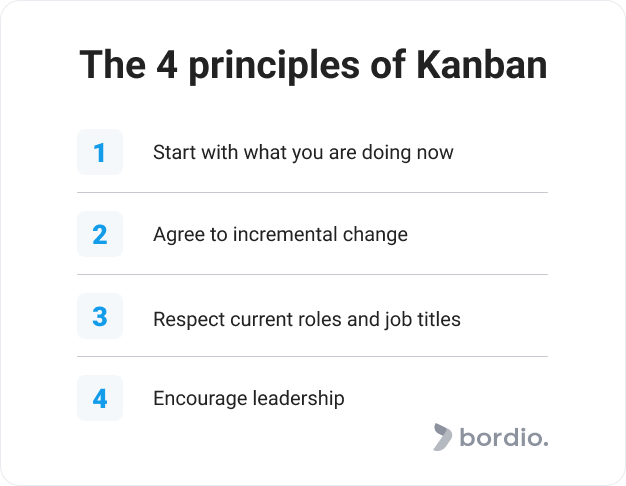Kanban is a visual workflow management method that helps teams visualize their work, limit work in progress, and maximize efficiency or flow. It is a popular Agile framework used to manage and improve work across human systems. This method helps teams identify bottlenecks and streamline their processes for continuous improvement.
Kanban is built on four fundamental principles that guide its implementation and practice:
1. Start with What You Do Now: Kanban encourages you to start with your existing workflow and make incremental improvements. Begin with your current processes and make gradual improvements.
2. Agree to Pursue Incremental, Evolutionary Change: Kanban promotes continuous improvement through small, incremental changes rather than large-scale transformations. Focus on making small, continuous changes rather than large-scale transformations.
3. Respect the Current Process, Roles, Responsibilities, and Titles: Kanban respects the current organizational structure and processes. Work within the existing organizational structure, making gradual improvements.
4. Encourage Acts of Leadership at All Levels: Leadership is not confined to management; anyone within the team can suggest and implement changes that lead to better outcomes. Empower all team members to suggest and implement improvements, fostering a culture of shared responsibility.
1. Kanban Board: A Kanban board is a tool that provides a visual overview of the work items. It typically consists of columns that represent the different stages of the workflow. The most basic structure includes three columns: "To Do," "In Progress," and "Done." Teams can customize their Kanban boards to reflect their specific workflow.
2. Work Items (Cards): Work items, or Kanban cards, represent tasks or units of work that need to be completed. Each card contains information about the task, such as a description, assignee, due date, and any other relevant details. Cards move across the board from one column to the next as the work progresses.
3. Columns: Columns on a Kanban board represent the different stages of the workflow. Common stages include "Backlog," "Ready," "In Progress," "Review," and "Done." Teams can add more columns as needed to reflect their process more accurately.
4. Work-in-Progress (WIP) Limits: WIP limits restrict the number of work items that can be in a particular column or stage at any given time. By limiting WIP, teams can identify bottlenecks, maintain a steady flow of work, and prevent overloading team members.
5. Swimlanes: Swimlanes are horizontal rows on a Kanban board that help categorize work items. They can be used to separate tasks by priority, team, project, or any other classification that helps organize the work.
6. Continuous Improvement: Kanban encourages continuous improvement through regular reviews and feedback. Teams analyze their workflow, identify inefficiencies, and make adjustments to enhance productivity. This is often facilitated through meetings like daily stand-ups and retrospectives.
- Visual Clarity: Kanban boards provide a clear visual representation of the workflow, making it easy to see the status of tasks and identify bottlenecks.
- Flexibility: Kanban is highly adaptable and can be customized to fit any team's workflow and processes.
- Improved Efficiency: By limiting WIP and focusing on continuous improvement, teams can optimize their processes and increase productivity.
- Enhanced Collaboration: The visual nature of Kanban boards fosters better communication and collaboration among team members.
- Set Up Your Kanban Board: Create columns that reflect your workflow stages and start adding tasks as cards.
- Define WIP Limits: Set WIP limits for each column to prevent overloading and ensure a steady flow of work.
- Use Swimlanes: Organize tasks using swimlanes to differentiate between various types of work or priorities.
- Review Regularly: Hold regular meetings to review progress, identify bottlenecks, and discuss improvements.
- Continuously Improve: Make adjustments to your process based on feedback and performance metrics to continually enhance your workflow.
Kanban is a powerful and flexible method for managing and improving work processes. By visualizing the workflow, limiting work in progress, and focusing on continuous improvement, teams can deliver high-quality results efficiently. The principles and components of Kanban help create a transparent and collaborative work environment, fostering a culture of continuous improvement and shared responsibility. Whether you're new to Agile methodologies or looking to enhance your current processes, Kanban provides a robust framework for achieving operational excellence and optimizing team performance.

